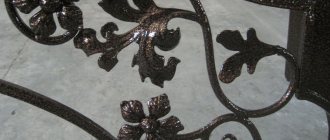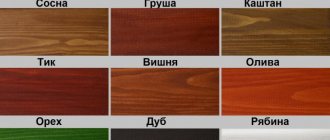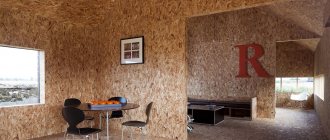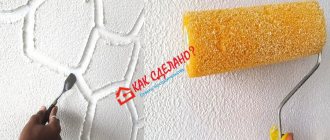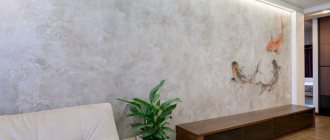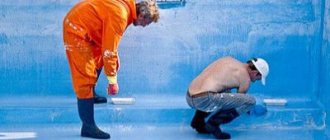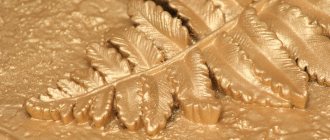Types of epoxy-based compounds and their properties
Epoxy paints are two-component - resin and hardener, powder, aerosol (used mainly for painting car parts). For domestic needs, mainly compositions based on cold-curing epoxy resin are used. Such paints harden after a day or more without additional exposure to the surface.
Manufacturing requires high-strength coatings, and these can only be obtained from hot-curing epoxy resin. Epoxy powder paints use a hot-curing resin, while two-component and aerosol paints use a cold-curing resin.
Important! The difference between the compositions is significant. During hot curing (polymerization), the network of paint molecules is thicker and stronger; during cold curing, it (the network) is thinner and does not have such strong molecular bonds.
The general properties of epoxy paints distinguish them from other coatings:
- create a durable surface.
- Suitable for painting both floors and walls.
- are waterproof, so can be used as waterproofing in bathrooms and for painting swimming pools.
- resistant to mechanical stress.
- resist various aggressive chemicals.
- have excellent adhesion to concrete, plastic and metal surfaces.
- Suitable for finishing floors in residential and industrial premises.
- a rich color palette and many textures allow you to embody interesting design ideas.
Aerosol paints are most often acrylic epoxy. They are characterized by high anti-corrosion properties, resistance to various chemical influences, including aggressive ones (suitable for outdoor use), and a high degree of self-cleaning (dust and dirt do not stick to the painted surface). Aerosol acrylic epoxy compounds form a durable glossy coating that is resistant to scratching and chipping.
There are several varieties of epoxy powder paints, which differ from each other in their technical characteristics:
- Standard. The polymerization process occurs in a chamber at a temperature of +220°C in the first 10 minutes of treatment.
- Low temperature. The polymerization process occurs in a chamber at a temperature of +180°C in the first 20 minutes.
- Polyester. They have high wear resistance, a rich palette of colors, textures (metallic, antique, clear varnish), gloss levels, and are low-toxic. They are used to provide maximum surface protection from friction and often replace primers.
- Epoxy-polyester. Such paints are inexpensive, have average abrasion resistance, are resistant to sunlight (do not turn yellow), high temperatures, scratching and other mechanical stress, and are resistant to aggressive chemical solvents and rust. At the same time, they are decorative - they are used as film coatings for precious metals and perfume bottles.
Main types of epoxy paint
This category is divided into:
- Aerosol paints (epoxy paint in cans for easy spraying);
- Powder;
- And two-component.
Powder versions are most often used in industry, as their performance indicators are too good. Therefore, on the one hand, in most cases, paint with such high characteristics is not required at home.
On the other hand, it hardens under the influence of a heating chamber, which is most often not used in ordinary residential premises.
Most often, when repairing and finishing residential premises, two-component paint is used. As is obvious from its name, it comes in two containers, the user needs to mix their contents independently to get the finished product
Deciding which epoxy paint to choose should be based on your needs, but keeping your budget in mind.
Compound
Epoxy paints consist of diane oligomers (molecular weight 1400 - 2500), modifiers, hardener, fillers and pigments, additional substances - hardening accelerators, viscosity and spreading regulators.
Epoxy paint composition
Two-component compositions for manual self-painting of metal parts consist of approximately 40% fillers: flow regulators, modifiers, and pigments. Powder epoxy coatings (thermal insulation) - they are called compounds and are always applied only in a thick layer - almost never contain modifiers and contain up to 70% fillers with a low coefficient of thermal expansion. This is usually quartz, represented by dust, or fiberglass.
Scope of application
Epoxy polyester, acrylic epoxy and epoxy paints are widely used in various fields. They form different types of surfaces - completely non-slip, protective, fluorescent, matte, glossy, textured, quick-drying.
The following compositions are used to paint:
- travel accessories;
- household items;
- internal and external parts of passenger cars;
- electrical appliances;
- decorative garden figurines;
- office furniture;
- radiators, heaters;
- toys;
- floors and walls;
- facades;
- containers with chemicals.
Epoxy paint can be used to paint concrete bathroom floors. This will protect them from moisture, and the neighbors below from leaks. In addition, this is an excellent alternative to ceramic tiles. This coating can be used to protect coils and other metal parts in bathrooms and kitchens from corrosion. If you cover wood with this paint, it will be reliably protected from rot and insects.
Characteristics
Two-part epoxy paints are an excellent paint option when you need to create a strong, long-lasting protective layer. The painted surface can withstand mechanical stress and the influence of aggressive chemicals without damage. Due to their high resistance, epoxy paints are used in many areas, both for exterior painting of outdoor objects, where there are poor, unfavorable climatic conditions, and for interior use, for painting premises for various purposes.
To paint a concrete floor, it is best to choose epoxy paint, as it will last much longer than other types of paints and varnishes. And walls painted with two-component epoxy paint will be able to withstand washing with caustic detergents.
The characteristics of these compositions allow them to be used for painting metal, concrete, wooden surfaces and other materials. Using only epoxy paint you can paint an entire room. Thanks to this versatility, the work process is simplified, since there is no need to purchase different types of dyes, which would increase the time required to complete the painting work. These paints fit perfectly on any substrate and have excellent adhesion to any materials.
Operating rules
Epoxy resin is a synthetic polymer. When combined with a hardener, a thermochemical reaction occurs, releasing a large amount of heat. Therefore, you need to work with two-component epoxy paints carefully, always following safety rules:
- Use special clothing when preparing and applying paint - gloves, overalls and a respirator are required. It's nice to have glasses too.
- Use special sticks to connect the composition. Never use food utensils.
- If paint does get on your skin, remove it immediately with denatured alcohol or wash with warm water and soap. If the composition hardens, it will be difficult to remove.
- Provide ventilation - open a window in the room where painting is carried out.
- Store cans of paint and hardener at a temperature not exceeding 40°C, away from heat sources and sunlight.
Important! Before painting, it is necessary to carry out a series of works to remove the old coating, clean and degrease the surface. If there are obvious chips and potholes, they must be repaired.
Compositions for concrete
Epoxy paint for concrete floors is a qualitatively new type of paint and varnish materials. If classic compositions based on epoxy resins are never mixed with water, since they become cloudy and lose some of their properties, then in the case of concrete paint, they add not ordinary water, but distilled water, resulting in an epoxy dispersion.
A striking representative of this type of paintwork material “Epostone” is a water-based epoxy primer-enamel for concrete floors. Among its technical characteristics it is worth highlighting the following:
- excellent adhesion to concrete;
- high wear resistance;
- resistance to non-concentrated chemicals;
- environmental cleanliness;
- weather resistance (allowed for outdoor use).
The most important positive quality of such enamel is its ability to be used on wet concrete. In addition to saving time, the technical characteristics of the coating itself are improved. Epoxy resin prevents moisture from evaporating from its surface. After gaining working strength, dusting of the surface is completely eliminated.
Features of painting various surfaces
Painting techniques for concrete, wood and concrete are slightly different. It is important to follow the rules for applying the composition to obtain an even coating.
Various tools are used to apply epoxy paint - the choice depends on the type of surface being treated.
Metal
Metal coating can be done with either aerosol or two-component paint. When choosing the first option, the can should be kept at a distance of 20 cm from the surface, evenly covering all areas of the workpiece. To apply the two-part look, you can use either a spray gun or a brush.
Concrete
The prepared concrete surface is easier to paint with a roller. It is recommended to use a two-component composition. The paint must be applied within 30 minutes after mixing. Thus, when processing too large an area, the composition should be prepared in small portions.
Wood
Wood can absorb small amounts of paint and varnish material. When painting, avoid heating. This will cause air to escape from the wood and cause bubbles to appear in the coating. Wood needs to be painted in several layers.
Preparatory work
There are two possible options for using epoxy primer-enamel on concrete - on a fresh concrete screed and on an old slab. Preparation processes vary.
In the first case, coloring is possible already 5 days after pouring. At this moment, the moisture content of the concrete is high enough, so the epoxy will penetrate deep into its pores, giving additional strength to the surface. In this case, leveling the floor is not required, but you will have to walk over it with a “helicopter” - a grinding machine - to remove the cement laitance and open the pores. If there is no helicopter, then the treatment needs to be done with a stiff brush. After this, thoroughly vacuum the surface.
If you are going to paint old concrete, you need to thoroughly prepare it - seal all the potholes (with epoxy putty) and remove any humps, if any. Then vacuum the surface. The moisture content of the old concrete pavement should not exceed 4%. Otherwise, the epoxy paint will begin to peel off pretty quickly.
Important! Potholes and cracks must be filled out, then priming is carried out and only after that puttying is carried out. The primer is prepared from the enamel primer that will be used for painting - it is diluted 10% with distilled water. After applying the primer layer, you must wait 12 hours to 24 hours for it to dry.
Selection rules
To select the right dye, it is important to consider the following nuances:
- what type of material will be painted. For example, if you need to treat a reinforced concrete or metal surface, then the best option would be to use an aerosol can rather than powder paint, because the aerosol dye has a high corrosion resistance;
- under what conditions the structure will be operated. It is important to think about the influence of atmospheric factors and the environment. If there is a heating chamber, then you can use powder dye; instead, you can use a two-component composition;
- it is necessary to take into account what loads the painted surface will experience. If, for example, the floor in a garage, boiler room or room with high traffic is being painted, then it is better to apply three or four layers for maximum protection, but for painting the ceiling one or two layers may be enough;
- To ensure that the coloring mixture does not run out during the process, you need to correctly calculate the required volume of paint.
Coloring instructions
The technology for applying epoxy primer-enamel to concrete is quite simple, but you must follow the instructions so as not to spoil the material:
- Thoroughly mix component A - epoxy resin with pigment and additives.
- Measure out the required amount of component A and mix it with component B (hardener). The ratio of parts is 100:17. Mixing time – no more than 3 and no less than 2 minutes. Let the mixture sit for about a quarter of an hour before starting work.
- Perform coloring.
Important! The lifespan of the finished paint is about 4 hours. Therefore, all work must be carried out quickly. The temperature of the base should not be lower than +15°C. The surface can be used in the range of -15 – +60°C.
Manufacturers
In practical use, epoxy primer-enamel for Russian concrete floors has proven itself best. Excellent reviews about Elakor-ED paint - this is also a Russian brand. Both samples do not contain inert fillers, the presence of which reduces the cost of the material, but at the same time reduces its properties.
Excellent quality epoxy paints from manufacturers from the USA. They are the most environmentally friendly and safe. They cost a little more, but the quality is worth it. Among the most famous American manufacturers it is worth highlighting:
- Aervoe;
- Ktisis;
- Rocol;
- ITW Spraytec;
- Huntsman Advanced Materials.
The choice of epoxy paints on the construction market is large. Finding the right quality material at the right price is quite difficult. Therefore, before purchasing, analyze for what purposes you need such paint and varnish, evaluate your financial capabilities, and only after that go to the construction market. And never buy epoxy compounds from a market where it is impossible to maintain proper storage conditions.
